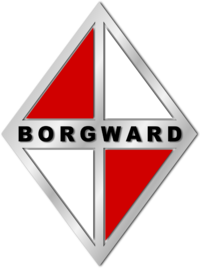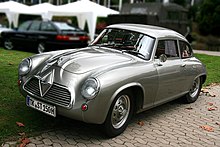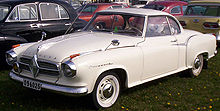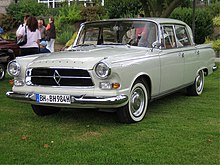This article is written like a personal reflection, personal essay, or argumentative essay that states a Wikipedia editor's personal feelings or presents an original argument about a topic. (September 2015) |
The former Borgward car manufacturing company, based in Bremen, Germany, was founded by Carl F. W. Borgward (1890–1963). It produced cars of four brands, which were sold to a diversified international customer base: Borgward, Hansa, Goliath and Lloyd. Borgward's Isabella was one of the most popular German premium models in the 1950s, while Lloyd's Alexander / Lloyd 600 model offered affordable mobility to many working-class motorists. The group ceased operations in 1961, following controversial insolvency proceedings.
 | |
| Company type | Private |
|---|---|
| Industry | Automotive |
| Founded | 1933 |
| Defunct | 1963 |
| Headquarters | Bremen, Germany |
Key people | Carl F. W. Borgward |
| Products | Automobiles |






The brand was revived in the 21st century, with the Stuttgart-based Borgward Group AG designing and marketing cars manufactured in China. After struggling to remain solvent, it also filed for bankruptcy in 2022.
History
editOrigins of the component companies
editThe origins of the company go back to 1905 with the establishment in Varel (near Bremen) of Hansa Automobilgesellschaft and the foundation in Bremen itself of NAMAG, maker of the Lloyd car. These two businesses merged in 1914 to form the "Hansa-Lloyd-Werke A.G." After the war, in the troubled economic situation then confronting Germany, the business failed to prosper and by the late 1920s faced bankruptcy. For Carl Borgward, already the successful creator of the Goliath-Blitzkarren business, the misfortunes of Hansa-Lloyd presented an opportunity to greatly expand the scope of his auto business, and he took control of it.[1]
Blitzkarren
editThe first vehicle Carl Borgward designed was the 1924 Blitzkarren (lightning cart), a tiny three-wheeled van with 2 hp (1.5 kW), which was successful in the market gap it filled.[citation needed] Traders with a small budget bought it for delivery. The Reichspost ordered many of them for postal service.
Hansa-Lloyd
editIn 1929, Borgward became the director of Hansa-Lloyd AG having been able to merge his Goliath-Werke Borgward & Co. with Hansa-Lloyd. The small Goliath-Blitzkarren had by now evolved into the three-wheeled timber-framed synthetic-leather-bodied 5 or 7 hp Goliath Pionier.[2] Borgward turned his attention to the other businesses and led the development of the Hansa Konsul. In February 1937, there came the new Hansa Borgward 2000 and in 1939 its name was shortened to Borgward 2000.[3] The 2000 model was followed by the Borgward 2300[3] which remained in production until 1942.
After World War II, in 1946 Carl Borgward used some of the brand names from businesses he had acquired over the years to found three separate companies: Borgward, Goliath and Lloyd.[4] This was intended to increase the quantity of steel allocated to his business at a time of austerity and rationing.[4] For many purposes the companies would be run as a single entity; but in a business operated by a man to whom delegation did not come naturally, the proliferation of legal entities nevertheless added unhelpful layers of complexity through the 1950s and encouraged a broadening of the range which in the end proved financially unsustainable with the sales volumes achievable.[5] In 1949 the company presented the Borgward Hansa 1500.[6]
One of the top engineers at Borgward from 1938 to 1952 was Dipl. Ing. Hubert M. Meingast.
Isabella and P100
editProduction of the Borgward Isabella began in 1954. The Isabella would become Borgward's most popular model and remained in production for the life of the company. In 1959 the Borgward P100 was introduced, equipped with pneumatic suspension.[7]
Sports racers
editBorgward introduced a line of 1500 cc sports racers in the 1950s, with the 16-valve engine from these becoming a successful Formula Two power unit (which was also used by some F1 privateers in 1961).[8]
Controversial company bankruptcy
editIn 1961, the company was forced into liquidation by creditors. Carl Borgward died in July 1963, still insisting the company had been technically solvent. This proved to be true in the sense that after the creditors were paid in full, there was still 4.5 million Marks left over from the business.[9][10]
Reports of difficulties at Borgward surfaced in an article that appeared in Germany's news magazine Der Spiegel on 14 December 1960.[11] A Spiegel article was highlighted by means of a picture of Borgward, cigar in mouth, on the magazine's front cover. It was strongly critical of his business approach, and included many of the arguments later advanced to explain or justify the company's demise. The widest range of cars from any manufacturer in Germany, produced by three till recently operationally autonomous companies (Borgward, Goliath and Lloyd) was supporting a turnover of only 650 million Marks, placing the overall sales value from the combined Borgward auto businesses only in fifth position among Germany's auto-makers. The 70-year-old Carl Borgward's "hands-on" insistence on an increasingly manic proliferation of new and modified models featuring adventurous, but under-developed technological innovations (fast manisch[e] Konstruierwut) gave rise to components which too often did not work, broke down or fell apart, resulting in massive bills for pre-delivery remediation and/or post delivery warranty work that found their way back to the company.[citation needed]
The December 1960 Der Spiegel article was not the only serious public criticism targeting Borgward at this time: suddenly stridently negative (if more succinct) comments also turned up in the mass-market Bild newspaper and in television reports. Critical media commentaries also appeared concerning large loans to the Borgward Group provided by the local Landesbank.[12]
It is apparent that the business was confronting cash-flow difficulties at the end of 1960. Capital intensive businesses such as auto manufacturing use their expensive machines and tools most efficiently if they use them constantly at full capacity, but the car market in Europe in the 1950s/60s was more seasonal than today, with sales diminishing in Winter, then peaking in the early summer months: Borgward's inventory of unsold cars at the end of 1960 was higher than usual, reflecting ambitious growth plans, most obviously in respect of the United States market[13] The December 1960 Der Spiegel article speculated that of the 15,000 Borgward cars ordered by the North American dealers in 1960 (and of the 12,000 delivered to them) 6,000 might have to be taken back following a slump in North American demand. (Borgward was not the only European auto maker hit by a North American slump in demand for imported cars during 1960. In the same year two ships carrying Renault Dauphines were turned back in mid-Atlantic because the docks in New York were overcrowded with unsold Dauphines.[14])
At the end of December 1960 Borgward approached the bank for a further one million Marks of credit, the loan to be backed by a guarantee from the Bremen regional government which initially the Bremen senators agreed to provide. However, following the flood of critical press comment the senators withdrew their guarantee. They now required Carl Borgward to pledge the company itself to the state in return for the guarantee. After a tense 13-hour meeting widely reported in a still hostile media, Borgward agreed to the senate's terms on 4 February 1961, thereby averting the bankruptcy of the business.[15]
The Bremen Senate also insisted on appointing its own nominee as chairman of the company's supervisory board. The man they chose was Johannes Semler whom reports generally describe as a "Wirtschaftsprüfer" (public auditor),[16] though this designation, especially once translated into English, does less than full justice to the breadth of Semler's career. He had studied law at university and worked initially as a lawyer. The scion of a leading Hamburg political family, in 1945 he had himself been a founding member of the centre-right CSU party, and was a member of the Bundestag between 1950 and 1953. Despite his Hamburg origins, Semler was by this time based in Munich, with a network of contacts in the Bavarian establishment that probably included fellow CSU politician and the future German chancellor, Ludwig Erhard, who in 1948 had succeeded Semler in a top administrative position within the Bizone. The appointment of Johannes Semler as the representative of the Bremen senators to chair the Borgward supervisory board would, in retrospect, contribute to the controversy that followed the Borgward bankruptcy.[17]
On 28 July 1961, Semler, as chairman of the supervisory board, joined the directors of the three companies Borgward, Goliath and Lloyd to instigate proceedings for the establishment of a "Vergleichsverfahren", which would have provided for a court sanctioned scheme of arrangement enabling the business to continue to trade while at the same time protecting the interests of creditors.[18] Two months later, however, in September 1961, the Borgward and Goliath businesses were declared bankrupt, followed in November by the Lloyd business. Subsequent "conspiracy theorists"[citation needed] have suggested that Semler, for reasons of his own, never had any intention of allowing the Borgward auto-businesses to survive.[19]
Post mortem
editThe German magazine Der Spiegel published a thoughtful piece in 1966, implying that with a little more support, and if the proprietor had been more willing to take advice from his own directors, the Borgward company could have easily overcome its financial problems of 1961. But Carl Borgward was financially naive and reluctant to accept advice: his preferred source of credit had always involved shunning the banks and simply taking extra time to pay his creditors, rejecting advice on the financing of his business from his own finance director. By autumn 1960 he was holding on to unpaid creditor invoices worth more than 100 Million Marks for sheet metal and tyres alone.[20][21] Given that all the company's creditors were eventually paid in full, the liquidation decision appeared nevertheless to have been taken prematurely.[20][22]
Production in Argentina
editBorgward Argentina was founded in 1954 as a joint venture of Carl F. Borgward HMBH and IAME (Aeronautics and Mechanical Industries) intended to equip the Rastrojero, a small pickup truck. The engine was manufactured at the plant that Borgward had in the town of Isidro Casanova, Buenos Aires province, at a production rate of 20 units per day with almost 800 employees. The production of Borgward Isabella was carried out in Cordoba city, by using Argentine engines, local components (glass, batteries, tires) and other pieces from Germany. This model production started in 1960 at the booming of Argentina automotive industry development, with a production plan of 500 units for that year.
When the German parent company closed its doors in 1961, the operation happened to have local control, and continued for a short time to complete the total manufacture of 1,050 cars during its short life in Argentine territory.[23]
Production in Mexico
editAs part of the bankruptcy process, in 1963, all manufacturing equipment for the Borgward Isabella and P100 was sold to a buyer in Monterrey, Mexico. Production in Mexico was delayed, but was started in August 1967[24] by entrepreneur and trucking magnate Gregorio Ramirez Gonzalez.[25] Production in Mexico ceased in 1970.[26]
Revival
editIn 2008, the Borgward Group AG was formed in Lucerne by Christian Borgward (grandson of Carl F. W. Borgward) and Karlheinz L. Knöss. The new company later moved to Stuttgart. With both investment and manufacture by Beiqi Foton Motor (a subsidiary of BAIC, a major Chinese automotive group), the Borgward group had started to sell SUVs by January 2017.
It filed for bankruptcy in Beijing on April 8, 2022.[27][28]
Models
editCars
edit- Borgward 2000
- Borgward 2300
- Borgward Arabella
- Borgward Hansa 1500
- Borgward Hansa 1800
- Borgward Hansa 1800 D
- Borgward Hansa 2400
- Borgward Isabella
- Borgward P100
- Borgward 230
Trucks
edit- Borgward B 611
- Borgward B 622
- Borgward B 655
- Borgward B 1000
- Borgward B 1000Z
- Borgward B 1250
- Borgward B 1500
- Borgward B 1500F
- Borgward B 2000
- Borgward B 2500
- Borgward B 3000
- Borgward B 4000
- Borgward B 4500
- Borgward B 522
- Borgward B 533
- Borgward B 544
- Borgward B 555
Military vehicles
edit- Sd.Kfz. 301 Borgward B IV
- Sd.Kfz. 302/303a/303b Goliath tracked mine
Aircraft
editHelicopters
editSee also
editReferences
edit- ^ Oswald, Werner (2001). Deutsche Autos 1945-1990, volume 4 (in German). Motorbuch Verlag. p. 424. ISBN 3-613-02131-5.
- ^ Oswald, Werner (2001). Deutsche Autos 1920-1945, volume 2 (in German). Motorbuch Verlag. p. 150. ISBN 3-613-02170-6.
- ^ a b Odin, L.C. World in Motion 1939 - The whole of the year's automobile production. Belvedere Publishing, 2015. ASIN: B00ZLN91ZG.
- ^ a b Kaack, Ulf (2012). Minimalismus auf vier Rädern [Minimalism on four wheels] (in German). GeraMond Verlag, München. p. 76. ISBN 978-3-86245-667-3.
{{cite book}}:|work=ignored (help) - ^ Kaack, Ulf (2012). Der Konkurs - Untergang des bremischen Automobilimperiums. GeraMond Verlag, München. pp. 17–19. ISBN 978-3-86245-667-3.
{{cite book}}:|work=ignored (help) - ^ Kaack, Ulf (2012). Traum-Pkw und robuste Lkw. GeraMond Verlag, München. pp. 23–25, 27. ISBN 978-3-86245-667-3.
{{cite book}}:|work=ignored (help) - ^ Peter Kurze: Borgward Typenkunde. Delius Klasing Verlag, Bielefeld 2009, ISBN 978-3-7688-2599-3, Page 84 and 96.
- ^ Heinrich Volker: Silberpfeile aus Bremen – Rennsportwagen der Borgward-Werke. Verlag Peter Kurze, Bremen 2004, ISBN 3-927485-43-8.
- ^ Borgward History Archived March 20, 2012, at the Wayback Machine
- ^ Vensky, Hellmuth (27 July 2011). "Der Niedergang eines Wirtschaftswunder-Unternehmens". ZEIT ONLINE. Retrieved 2013-05-14.
Fraglich ist aus heutiger Sicht, ob Borgward tatsächlich zahlungsunfähig war: Am Ende des Verfahrens werden die Ansprüche aller Gläubiger befriedigt, es bleiben sogar 4,5 Millionen Mark übrig.
- ^ Augstein, Rudolf; Becker, Hans Detlev, eds. (14 December 1960). "Der Bastler". Der Spiegel (51). Retrieved 2013-05-15.
Wie kein anderer Automobilfabrikant der Welt hetzte Carl F. W. Borgward in seinen drei Werken von Neukonstruktion zu Neukonstruktion…. Modelle, Typen und Marken entstanden und verschwanden, tauchten mit abgewandelten Formen, veränderter Ausrüstung und ausgetauschten Marken wieder auf und hinterließen beim Käufer die Empfindungen eines Wechselbades.
- ^ Vensky, Hellmuth (27 July 2011). "Der Niedergang eines Wirtschaftswunder-Unternehmens". Die Zeit. Retrieved 2013-05-14.
Es ist nicht die einzige kritische Geschichte, die in diesen Tagen über Borgward geschrieben wird. Heutige Fans der Marke vermuten eine Verschwörung der Konkurrenz hinter dem plötzlich so schlechten Image, das Berichte in Bild-Zeitung und Tagesschau hinterlassen.... Die öffentlich-rechtliche Bremer Landesbank gewährt dem Konzern hohe Kredite, die [auch] in den Medien kritisch thematisiert werden.
- ^ Vensky, Hellmuth (27 July 2011). "Der Niedergang eines Wirtschaftswunder-Unternehmens". Die Zeit. Retrieved 2013-05-14.
Neben den Problemen mit der Modellpolitik schwächen rückläufige Verkaufszahlen im für Borgward wichtig gewordenen US-Markt die Liquidität der Firma..
- ^ "Autos: Compacts in Paris". Time. October 17, 1960. Archived from the original on October 31, 2010.
- ^ Vensky, Hellmuth (27 July 2011). "Der Niedergang eines Wirtschaftswunder-Unternehmens". Die Zeit. Retrieved 2013-05-14.
Ende 1960 beantragt Borgward einen weiteren Millionenkredit, um über den Winter zu kommen – in der kalten Jahreszeit werden weniger Autos verkauft. [...] Borgward willigt am 4. Februar 1961 nach 13 Stunden dramatischer Verhandlungen mit dem Senat ein, um die Insolvenz zu vermeiden."
- ^ Vensky, Hellmuth (27 July 2011). "Der Niedergang eines Wirtschaftswunder-Unternehmens". Die Zeit. Retrieved 2013-05-14.
Der Senat beruft den Münchener Wirtschaftsprüfer Johannes Semler zum Vorsitzenden des Aufsichtsrates.
- ^ Vensky, Hellmuth (27 July 2011). "Der Niedergang eines Wirtschaftswunder-Unternehmens". Die Zeit. Retrieved 2013-05-14.
...für die Verschwörungstheoretiker unter den Borgward-Fans gefundenes Fressen, denn Semler hat den gleichen Job auch bei BMW in Muenchen, damals ebenfalls ein Sanierungsfall.
- ^ A similar process in the US would involve a Chapter 11 bankruptcy.
- ^ Vensky, Hellmuth (27 July 2011). "Der Niedergang eines Wirtschaftswunder-Unternehmens". Die Zeit. Retrieved 2013-05-14.
Am 28. Juli 1961 beantragen der Aufsichtsratschef der Holding und die drei Geschäftsführer der Borgward-, Lloyd- und Goliath-GmbH die Eröffnung von Vergleichsverfahren. Diese gerichtlichen Verfahren haben im damaligen Insolvenzrecht den Sinn, einen Konkurs noch abzuwenden. Doch im September 1961 gehen Borgward und Goliath, im November Lloyd in Konkurs.
- ^ a b History of Borgward Archived March 3, 2016, at the Wayback Machine
- ^ Augstein, Rudolf; Jacobi, Claus, eds. (12 December 1966). "Hüter des Hauses". Der Spiegel (51). Retrieved 2013-05-15.
So tüchtig wie als Konstrukteur, so naiv war Borgward im Umgang mit Geld. Er lehnte Bankkredite ab und finanzierte sich über seine Lieferanten, deren Rechnungen er jeweils erst nach drei Monaten beglich.....Da er überdies ständig neue Typen entwickelte und keinen Widerspruch duldete (Borgward zu seinem Finanzdirektor Carstens: "Sie sind ja doof, ich weiß schon, wo mein Geld bleibt"), waren seine Finanzen schließlich durcheinander geraten. Im Herbst 1960 schuldete das Unternehmen den Blech- und Reifenlieferanten mehr als 100 Millionen Mark.
- ^ Augstein, Rudolf; Jacobi, Claus, eds. (12 December 1966). "Hüter des Hauses". Der Spiegel (51). Retrieved 2013-05-15.
Als der Bremer Autokonzern 1961 zusammenbrach, tauchten die ersten Zweifel am deutschen Wirtschaftswunder auf. Heute zeigt sich, daß Borgward voreilig in den Konkurs getrieben wurde.
- ^ "Borgward Factory Argentina". Borgward.uk. Retrieved 2010-06-12.
- ^ "News and views: Borgward in Mexico". Autocar. Vol. 127 (nbr 3732). 24 August 1967. p. 52.
- ^ Sabal, Leonard E. (March 1969). "Conozca Ud. el Borgward Mexicano" [Get to know the Mexican Borgward]. Mecánica Popular (in Mexican Spanish). Vol. 45, no. 3. p. 33. Archived from the original on 2014-08-23.
- ^ "Brief Borgward History". Borgwardisabella.com. Archived from the original on 2010-03-23. Retrieved 2010-06-12.
- ^ "Germany's Borgward brand declared bankrupt in China". Automotive News Europe. 2022-12-02. Archived from the original on 2022-12-05. Retrieved 2022-12-30.
- ^ "Beijing Borgward files for bankruptcy". Gasgoo. Retrieved 2022-12-30.
External links
edit- Borgward Drivers Club UK
- Borgward Interessengemeinschaft Essen (in English)
- Borgward Club of Australia
- Borgward Registry
- Dipl. Ing. Hubert M. Meingast (Borgward Engineer and Research Scientist) (in English)
- Interactive Panorama from inside a Borgward Isabella Archived 2020-08-01 at the Wayback Machine
- Interactive Panorama from inside a Hansa 1100 Archived 2020-08-01 at the Wayback Machine
- Interactive Panorama from inside a Lloyd Archived 2020-08-01 at the Wayback Machine
- Documents and clippings about Borgward in the 20th Century Press Archives of the ZBW